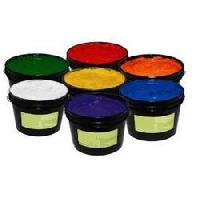The optimal results of perfect screen printing depend on selecting the correct ink. Proper selection of ink can have a greater impact on your screen printing project. The durability and overall quality of your prints come from the correct ink.
PLASTISOL INK
Most people involved in screen printing tend to use Plastisol ink. It is thick, durable, versatile, and provides precise graphic detail. Plastisol ink is also easy to mix, long-lasting, widely available, and comes in various colors, making it compatible with different screen printing methods, equipment, and designs. It can also stay on the screen for long periods without drying out.
This type of ink’s high density prevents it from arching, and its low viscosity allows it to work well with softer prints. It also provides a low-gloss, flat finish. Plastisol ink needs heat to dry.
WATER-BASED INK
Some people prefer water-based ink because it soaks into the fabric fibers on which it is used rather than sitting on top, as Plastisol does. It gives the screen print a softer feel than those made using Plastisol ink. Some people also find that it provides the print with a more solid feel.
Water-based inks are easy to use, even for printers without much experience or skill. However, it can take a longer time to dry in humid conditions and may require the use of a heat source. This type of ink is semi-transparent and may require custom color matching to produce a uniform look throughout the garment. It may also need a high-count mesh screen and a retarder to prevent design flooding.
DISCHARGE INK
Discharge ink is available in both Plastisol and water-based types. When using discharge ink, the ink removes the fabric’s color on the areas where it is applied and replaces it with its pigment. It makes discharge ink popular for people working with 100% cotton.
To fully cure, it is necessary to use a heat source for fabrics silk-screened with discharge ink. Using this type of ink does require a relatively high level of expertise.
Ink for Screen Printing Machines
Ink is an essential material for screen printing machines, but there is often confusion about choosing the most suitable ink. Particularly, the new entrepreneurs with screen printing businesses become hesitant to select the ink considered best for their printing job. Of course, beginners must find the solution to choose the proper ink for their screen printers.
However, to solve this problem, the new entrepreneur must think first about what will be printed. Then, consider the best matching ink for the particular printing item. Broadly, for screen print jobs, it is necessary to choose the proper ink from two categories:
(i) Water-based and
(ii) Plastisol.
Both inks are for the screen printing job. First, analyze both inks and select the best one for the printing job.
Plastisol Ink is More Suitable for dark colors:

The materials mainly used for this ink are plasticizer liquid and polyvinyl chloride (PVC). It is thick and seems rough to touch. Plastisol ink adheres to the top of the fabric and does not cause the fabric to die.
Simple to Use, Enormous for Gloomy Clothes:
Plastisol is highly suitable for garments that are heavy, such as sweatshirts. It provides lively prints with your screen printing machine on gloomy cloth.
The quality of jerseys improves with thick printing using Plastisol. Printing with Plastisol is easier than with water-based ink, and it can be disposed of with less effort than water-based ink.
Limitations of Plastisol Ink
– Not easy to breathe for a thick and rubbery nature.
– To set Plastisol, use a temperature of 320°F with a specific time limit; otherwise, the ink will remain wet until the PVC resin and plasticizer fluid bond.
– Not easy to print on cloth made of soft cotton.
– It causes Fibrillation (poke of small fiber through the print)
– After some washcloths printed with Plastisol could get split.
Water-Based Ink
– Easy to discharge from the pot due to its thin and runny quality.
– Could produce quality print, transparent, and soft to the touch.
– Printing with water-based ink, the classic presentation can be produced.
– More suitable for medium and light-colored fabrics.
– Fashion wear becomes more attractive, with water-based print.
– Can be dried through air, subject to providing the required time.
However, your choice of precisely suitable ink becomes easier as several ink manufacturers add extra ingredients to their ink, allowing you to create an excellent mixture for your print. Therefore, you can easily collect the proper ink for your screen printing machine according to your choice and budget.
Get More Ideas :

Leave a Reply
You must be logged in to post a comment.